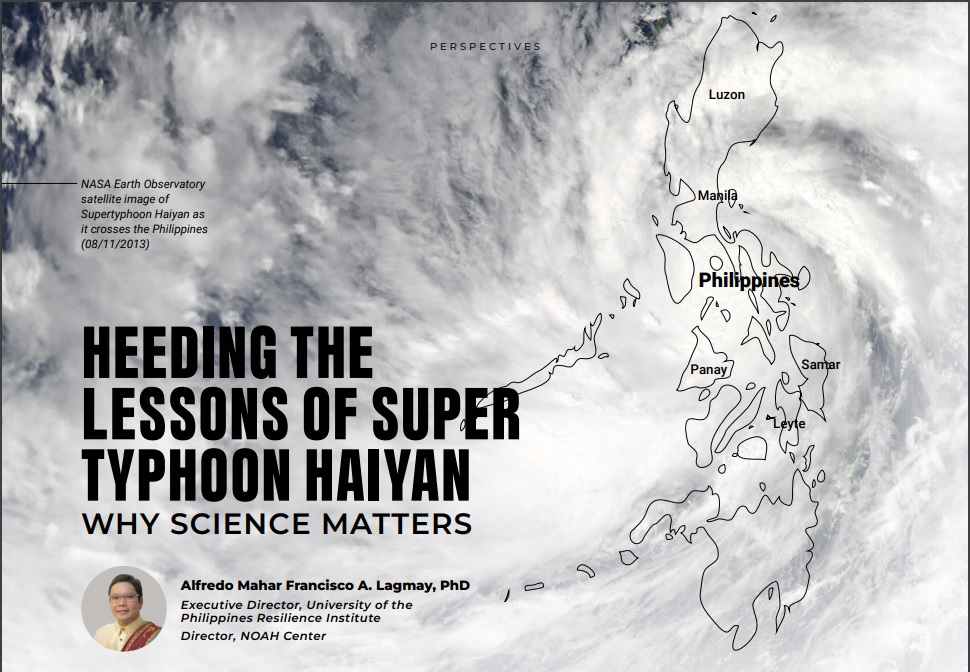 Screenshot of Dr. Lagmay’s article header from The ASEAN Magazine Special Edition Issue No. 40
Screenshot of Dr. Lagmay’s article header from The ASEAN Magazine Special Edition Issue No. 40
The ASEAN Magazine invited Dr. Alfredo Mahar Lagmay to contribute an article to the special edition of their magazine, which features the 20th anniversary of the Indian Ocean Tsunami. The featured article recounts how Super Typhoon Haiyan devastated the Philippines back in 2013. In its wake, there were arguments regarding responsibility and culpability; the so-called “blame game”, as everyone demanded an explanation for the high loss of life. However, one accusation stood out, which was that the government hazard maps had underestimated the strength of the typhoon. This resulted in pre-positioned relief goods being washed away and rescue personnel becoming the victims instead. Almost all of the government evacuation centers were also within the storm surge danger zone, and many people who had thought they were safe were still inundated in their evacuation centers.
The use of Deterministic Risk Assessment, which is based primarily on historical accounts, was the reason for the underestimation of the strength of the storm surge. Hazard maps based on this type of approach did not take into account the increasing severity of typhoons due to climate change and failed to predict typhoons that were more powerful than previously on record. The article mentioned that what was needed by the country before typhoons make land-fall were hazard maps that feature or parallel that of severe hazards formerly recorded or remembered; the kind of approach that feature hazard simulations are vital for a more accurate and precise hazard profiling, this is called Probabilistic Risk Assessment. A kind of approach which models multiple scenario that includes both historical and unfamiliar events. If the use of Probabilistic Risk Assessment had been available at the time, then this kind of approach would have saved lives. Had the authorities used hazard maps based on multi-scenario tools, they would have seen that the evacuation centers would have been within the danger zone of the storm surge. It was one year after Haiyan, in 2014, that the first Probabilistic Risk Assessment based hazard maps, including ones for landslides and storm surges, had been produced for over 171 cities and municipalities. These maps were created through the Nationwide Operational Assessment of Hazards (NOAH) Project of the Department Of Science and Technology (DOST) or Project NOAH-DOST, which was the foundation for disaster risk reduction in the Philippines at the time. These maps can still be accessed by the general public through the NOAH website (https://noah.up.edu.ph/), which is now managed by the University of the Philippines Resilience Institute as a core component in the efforts of conducting research and public service related to climate and disaster resilience.
A key part for a people-centered early warning system involves hazard warning that allows for timely action against hazards. The people-centered early warning system includes four interrelated key elements: (1) disaster risk knowledge based on the systematic collection of data and disaster risk assessments; (2) detection, monitoring, analysis, and forecasting of the hazards and possible consequences; (3) dissemination and communication, by an official source, of authoritative, timely, accurate and actionable warnings and associated information on likelihood and impact; and (4) preparedness at all levels to respond to the warnings received. These elements have been integrated through the National Disaster Risk Reduction Management Council (NDRRMC), and they in part institutionalized the Pre-Disaster Risk Assessment (PDRA) to avoid repeating the same mistakes made during Typhoon Haiyan. However, the governments hazard maps still continue to use hazard maps solely informed by historical data, so there is still much more work to be done to fully absorb the lessons learned.
The full article highlighting the works by Dr. Alfredo Mahar Lagmay and other related articles featured in The ASEAN Special Edition Issue No. 40 can be accessed by clicking on this link.
The ASEAN magazine Special Edition can be accessed and downloaded directly through the following links:
- The ASEAN Special Issue No. 39, 20 Years After the Indian Ocean Tsunami (Part 1): Building on Lessons Learned: https://asean.org/serial/building-on-lessons-learned/
- The ASEAN Special Issue No. 40, 20 Years After the Indian Ocean Tsunami (Part 2): The Path to Sustainable Resilience: https://asean.org/serial/the-path-to-sustainable-resilience/
